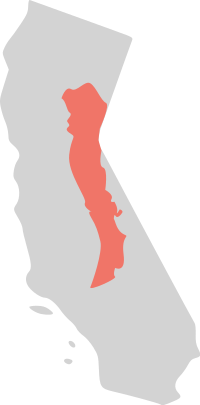Our website is made possible by displaying online advertisements to our visitors.
Please consider supporting us by disabling your ad blocker.
Sierra Nevada
| Sierra Nevada | |
|---|---|
 The Sierra's Mills Creek cirque (center) is on the west side of the Sierra Crest, south of Mono Lake (top, blue). | |
| Highest point | |
| Peak | Mount Whitney |
| Elevation | 14,505 ft (4,421 m)[1] |
| Coordinates | 36°34′42.9″N 118°17′31.2″W / 36.578583°N 118.292000°W |
| Dimensions | |
| Length | 400 mi (640 km) north-south from Fredonyer Pass to Tehachapi Pass[2] |
| Width | 80 mi (130 km)[3] |
| Area | 24,370 sq mi (63,100 km2)[4] |
| Naming | |
| Etymology | 1777: Spanish for "snowy mountain range" |
| Nicknames | |
| Geography | |
| Country | United States |
| States |
|
| Range coordinates | 38°00′N 119°30′W / 38.000°N 119.500°W |
| Geology | |
| Rock age | Mesozoic |
| Rock types |
|
The Sierra Nevada (/siˌɛrə nɪˈvædə, -ˈvɑːd-/ see-ERR-ə nih-VA(H)D-ə)[6][a] is a mountain range in the Western United States, between the Central Valley of California and the Great Basin. The vast majority of the range lies in the state of California, although the Carson Range spur lies primarily in Nevada. The Sierra Nevada is part of the American Cordillera, an almost continuous chain of mountain ranges that forms the western "backbone" of the Americas.
The Sierra runs 400 mi (640 km) north-south, and its width ranges from 50 mi (80 km) to 80 mi (130 km) across east–west.[3] Notable features include General Sherman, the largest tree in the world by volume; Lake Tahoe, the largest alpine lake in North America; Mount Whitney at 14,505 ft (4,421 m),[1] the highest point in the contiguous United States; and Yosemite Valley sculpted by glaciers from one-hundred-million-year-old granite, containing high waterfalls. The Sierra is home to three national parks, twenty-six wilderness areas, ten national forests, and two national monuments. These areas include Yosemite, Sequoia, and Kings Canyon National Parks, as well as Devils Postpile National Monument.
More than one hundred million years ago during the Nevadan orogeny, granite formed deep underground. The range started to uplift less than five million years ago,[8] and erosion by glaciers exposed the granite and formed the light-colored mountains and cliffs that make up the range. The uplift caused a wide range of elevations and climates in the Sierra Nevada, which are reflected by the presence of five life zones (areas with similar plant and animal communities). Uplift continues due to faulting caused by tectonic forces, creating spectacular fault block escarpments along the eastern edge of the southern Sierra.
The Sierra Nevada has played an important role in the history of California and the United States. The California gold rush occurred in the western foothills from 1848 through 1855. Due to its inaccessibility, the range was not fully explored until 1912.[9]: 81
- ^ a b "Mount Whitney". NGS Data Sheet. National Geodetic Survey, National Oceanic and Atmospheric Administration, United States Department of Commerce.
- ^ "Sierra Nevada". Ecological Subregions of California. United States Forest Service. Archived from the original on December 5, 2010.
- ^ a b "Sierra Nevada". SummitPost.org. Archived from the original on September 17, 2020. Retrieved May 29, 2010.
- ^ Cite error: The named reference
gapwas invoked but never defined (see the help page). - ^ Muir, John (1894). "Chapter 1: The Sierra Nevada". The Mountains of California. Archived from the original on April 10, 2014. Retrieved May 29, 2010.
- ^ Wells, John C. (2008). Longman Pronunciation Dictionary (3rd ed.). Longman. ISBN 978-1-4058-8118-0.
- ^ Carlson, Helen S. (1976). Nevada Place Names: A Geographical Dictionary. University of Nevada Press. p. 215. ISBN 978-0-87417-094-8.
- ^ "Cascade-Sierra Mountains Province (U.S. National Park Service)". www.nps.gov. Archived from the original on February 12, 2022. Retrieved February 12, 2022.
- ^ Cite error: The named reference
roperwas invoked but never defined (see the help page).
Cite error: There are <ref group=lower-alpha> tags or {{efn}} templates on this page, but the references will not show without a {{reflist|group=lower-alpha}} template or {{notelist}} template (see the help page).
Previous Page Next Page
Sierra Nevada (Verenigde State) AF سييرا نيفادا (الولايات المتحدة) Arabic سييرا نيفادا (سلسله جبليه فى امريكا) ARZ Syerra-Nevada (ABŞ) AZ Сьерра-Невада (АҠШ) BA Сьера-Невада (ЗША) BE Сиера Невада (САЩ) Bulgarian সিয়েরা নেভাদা Bengali/Bangla Sierra Nevada (Stadoù-Unanet) BR Sierra Nevada (Estats Units) Catalan



